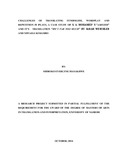| dc.description.abstract | This study explores on the unique challenges of Swahili-English translation. The paper has
also attempted to bridge the gap brought about by differences in culture between these two
languages. It explores the possibility of compromise between practical concerns related to
readability of TT as exactly as the ST reader. This is was has given birth to our topic on
challenges that translators dealing with dramatic texts are likely to encounter, as they
translate symbolism, wordplay and repetition, in Amezidi and its translation He‟s Far Too
Much, and how best they can deal with these challenges which occur at cultural level.
The study looks at what is omitted, what is added and what is circumlocuted in the TT in
order to bring out the equivalence effect or near equivalence to the target reader in the ST
The study also investigates what should be retained, what should be literally translated and
what should be changed for the reader of the TT to understand what the author of the source
text intends to be understood.
Finally the paper looks at strategies that can be employed to deal with such challenge, which
may arise as a translator transposes symbolism, wordplay and repetition from Swahili to
English. We apply both the qualitative and quantitative method to analyze the said challenges
and make conclusions with regard to how symbolism, wordplay and repetition have been
dealt with by Weschler S and Kimambo N, in the English version of ―Amezidi”.
Our main objective is to identify any ‗mistranslations‘ and look into factors contributing
towards these and then make suggestions on how to deal with such challenges.
This dissertation consists of five chapters. Chapter one deals with the introductory elements
of the study which include the introduction, the background of the study, the statement of the
problem research objectives, research questions, significance of the study, scope and
limitations, theoretical framework, literature review, research methodology and conclusion.
Chapter two on the other hand deals with the analysis of symbolism, wordplay and
repetition in the English version of Amezidi. And this chapter is further divided into three sub
sections namely definition of terms, how the translators have exhibited wordplay symbolism and wordplay in both TT and ST and the choices they are forced to make or the challenges
they may encountered
Chapter three focuses on findings and comments on the said findings by highlighting
challenges which translators of dramatic texts are likely to encounter as they deal with
translating symbolism, wordplay and repetition.
Chapter four suggests strategies that translators of dramatic texts can employ in order to
deal with the aforesaid challenges.
Chapter five concludes the project and suggests recommendations for further research. | en_US |

